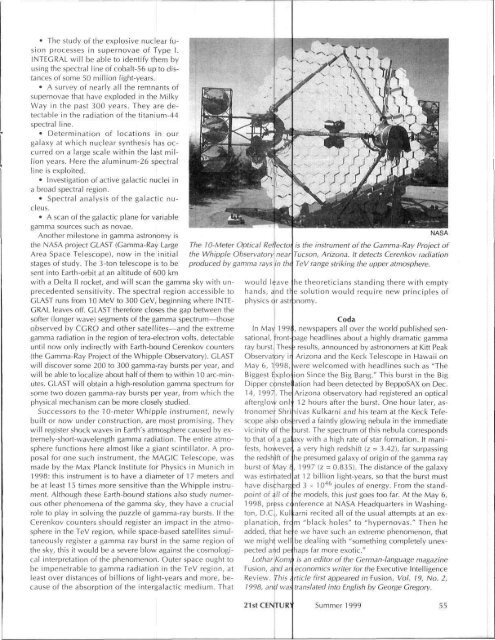Back to the Moon with Nuclear Rockets
Back to the Moon with Nuclear Rockets
Back to the Moon with Nuclear Rockets
- No tags were found...
Create successful ePaper yourself
Turn your PDF publications into a flip-book with our unique Google optimized e-Paper software.
• The study of <strong>the</strong> explosive nuclear fusionprocesses in supernovae of Type I.INTEGRAL will be able <strong>to</strong> identify <strong>the</strong>m byusing <strong>the</strong> spectral line of cobalt-56 up <strong>to</strong> distancesof some 50 million light-years.• A survey of nearly all <strong>the</strong> remnants ofsupernovae that have exploded in <strong>the</strong> MilkyWay in <strong>the</strong> past 300 years. They are detectablein <strong>the</strong> radiation of <strong>the</strong> titanium-44spectral line.• Determination of locations in ourgalaxy at which nuclear syn<strong>the</strong>sis has occurredon a large scale <strong>with</strong>in <strong>the</strong> last millionyears. Here <strong>the</strong> aluminum-26 spectralline is exploited.• Investigation of active galactic nuclei ina broad spectral region.• Spectral analysis of <strong>the</strong> galactic nucleus.• A scan of <strong>the</strong> galactic plane for variablegamma sources such as novae.Ano<strong>the</strong>r miles<strong>to</strong>ne in gamma astronomy is<strong>the</strong> NASA project GLAST (Gamma-Ray LargeArea Space Telescope), now in <strong>the</strong> initialstages of study. The 3-<strong>to</strong>n telescope is <strong>to</strong> besent in<strong>to</strong> Earth-orbit at an altitude of 600 km<strong>with</strong> a Delta II rocket, and will scan <strong>the</strong> gamma sky <strong>with</strong> unprecedentedsensitivity. The spectral region accessible <strong>to</strong>GLAST runs from 10 MeV <strong>to</strong> 300 GeV, beginning where INTEGRAL leaves off. GLAST <strong>the</strong>refore closes <strong>the</strong> gap between <strong>the</strong>softer (longer wave) segments of <strong>the</strong> gamma spectrum—thoseobserved by CGRO and o<strong>the</strong>r satellites—and <strong>the</strong> extremegamma radiation in <strong>the</strong> region of tera-electron volts, detectableuntil now only indirectly <strong>with</strong> Earth-bound Cerenkov counters(<strong>the</strong> Gamma-Ray Project of <strong>the</strong> Whipple Observa<strong>to</strong>ry). GLASTwill discover some 200 <strong>to</strong> 300 gamma-ray bursts per year, andwill be able <strong>to</strong> localize about half of <strong>the</strong>m <strong>to</strong> <strong>with</strong>in 10 arc-minutes.GLAST will obtain a high-resolution gamma spectrum forsome two dozen gamma-ray bursts per year, from which <strong>the</strong>physical mechanism can be more closely studied.Successors <strong>to</strong> <strong>the</strong> 10-meter Whipple instrument, newlybuilt or now under construction, are most promising. Theywill register shock waves in Earth's atmosphere caused by extremely-short-wavelengthgamma radiation. The entire atmospherefunctions here almost like a giant scintilla<strong>to</strong>r. A proposalfor one such instrument, <strong>the</strong> MAGIC Telescope, wasmade by <strong>the</strong> Max Planck Institute for Physics in Munich in1 998: this instrument is <strong>to</strong> have a diameter of 1 7 meters andbe at least 15 times more sensitive than <strong>the</strong> Whipple instrument.Although <strong>the</strong>se Earth-bound stations also study numerouso<strong>the</strong>r phenomena of <strong>the</strong> gamma sky, <strong>the</strong>y have a crucialrole <strong>to</strong> play in solving <strong>the</strong> puzzle of gamma-ray bursts. If <strong>the</strong>Cerenkov counters should register an impact in <strong>the</strong> atmospherein <strong>the</strong> TeV region, while space-based satellites simultaneouslyregister a gamma ray burst in <strong>the</strong> same region of<strong>the</strong> sky, this it would be a severe blow against <strong>the</strong> cosmologicalinterpretation of <strong>the</strong> phenomenon. Outer space ought <strong>to</strong>be impenetrable <strong>to</strong> gamma radiation in <strong>the</strong> TeV region, atleast over distances of billions of light-years and more, becauseof <strong>the</strong> absorption of <strong>the</strong> intergalactic medium. ThatThe 10-Meter Optical Reflec<strong>to</strong>i is <strong>the</strong> instrument of <strong>the</strong> Gamma-Ray Project of<strong>the</strong> Whipple Observa<strong>to</strong>ry near Tucson, Arizona. It detects Cerenkov radiationproduced by gamma rays in tht TeV range striking <strong>the</strong> upper atmosphere.21stCENTUR >NASAwould leave he <strong>the</strong>oreticians standing <strong>the</strong>re <strong>with</strong> emptyhands, and tr e solution would require new principles ofphysics or astr anomy.CodaIn May 199!, newspapers all over <strong>the</strong> world published sensational,front- 3age headlines about a highly dramatic gammaray burst. Thes > results, announced by astronomers at Kitt PeakObserva<strong>to</strong>ry ir Arizona and <strong>the</strong> Keck Telescope in Hawaii onMay 6, 1998, were welcomed <strong>with</strong> headlines such as "TheBiggest Explo; ion Since <strong>the</strong> Big Bang." This burst in <strong>the</strong> BigDipper constel ation had been detected by BeppoSAX on Dec.14, 1997. The Arizona observa<strong>to</strong>ry had registered an opticalafterglow onl' 12 hours after <strong>the</strong> burst. One hour later, astronomerShri n'vas Kulkarni and his team at <strong>the</strong> Keck Telescopealso observed a faintly glowing nebula in <strong>the</strong> immediatevicinity of <strong>the</strong> Durst. The spectrum of this nebula corresponds<strong>to</strong> that of a gal axy <strong>with</strong> a high rate of star formation. It manifests,however, a very high redshift (z = 3.42), far surpassing<strong>the</strong> redshift of he presumed galaxy of origin of <strong>the</strong> gamma rayburst of May f, 1997 (z = 0.835). The distance of <strong>the</strong> galaxywas estimated at 1 2 billion light-years, so that <strong>the</strong> burst musthave discharg ;d 3 x 10 46 joules of energy. From <strong>the</strong> standpoin<strong>to</strong>f all of he models, this just goes <strong>to</strong>o far. At <strong>the</strong> May 6,1998, press conference at NASA Headquarters in Washing<strong>to</strong>n,D.C., Kul ;arni recited all of <strong>the</strong> usual attempts at an explanation,frc m "black holes" <strong>to</strong> "hypernovas." Then headded, that he e we have such an extreme phenomenon, thatwe might well be dealing <strong>with</strong> "something completely unexpectedand pei haps far more exotic."Lothar /Com/ > is an edi<strong>to</strong>r of <strong>the</strong> German-language magazineFusion, and an economics writer for <strong>the</strong> Executive IntelligenceReview. This i rticle first appeared in Fusion, Vol. 19, No. 2,1998, and was translated in<strong>to</strong> English by George Gregory.
















